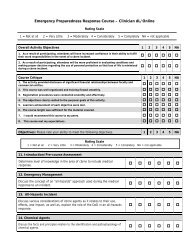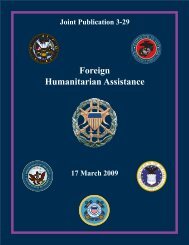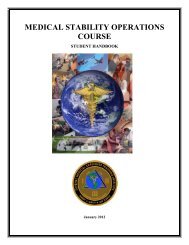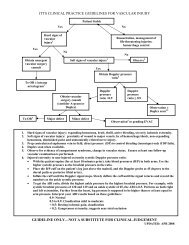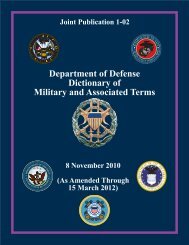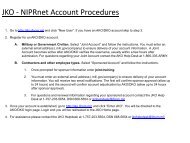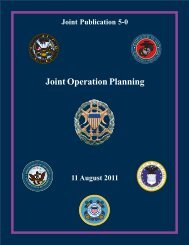- Page 1 and 2: Joint Publication 4-02 Health Servi
- Page 3 and 4: Preface Intentionally Blank ii JP 4
- Page 5 and 6: Summary of Changes Intentionally Bl
- Page 7 and 8: Table of Contents • Special Opera
- Page 9 and 10: Table of Contents Intentionally Bla
- Page 11 and 12: Executive Summary Care Capabilities
- Page 13 and 14: Executive Summary Patient Movement.
- Page 15 and 16: Executive Summary geography, indivi
- Page 17: Chapter I 2. Purpose The purpose of
- Page 21 and 22: Chapter I 10. En Route Capability a
- Page 23 and 24: Chapter I f. The Assistant Secretar
- Page 25 and 26: Chapter I (7) Coordinates PM throug
- Page 27 and 28: Chapter I (19) In conjunction with
- Page 29 and 30: Chapter I Intentionally Blank I-14
- Page 31 and 32: Chapter II TYPICAL JOINT TASK FORCE
- Page 33 and 34: Chapter II (1) Expect to receive br
- Page 35 and 36: Chapter II (14) Evaluate and charac
- Page 37 and 38: Chapter II (42) Ensure communicatio
- Page 39 and 40: Chapter II (m) Ensuring that detain
- Page 41 and 42: Chapter II LNOs). (13) Liaison offi
- Page 43 and 44: Chapter II (e) Supervising the deve
- Page 45 and 46: Chapter II 8. Advise the JTFS on a
- Page 47 and 48: Chapter II 3. Maintain the daily st
- Page 49 and 50: Chapter II 3. Form, organize, and o
- Page 51 and 52: Chapter II 17. Maintain thorough kn
- Page 53 and 54: Chapter II 16. Establish procedures
- Page 55 and 56: Chapter II (d) Ensure the receipt a
- Page 57 and 58: Chapter II humanitarian and civic a
- Page 59 and 60: Chapter II SAMPLE JOINT TASK FORCE
- Page 61 and 62: Chapter II c. In coordination with
- Page 63 and 64: Chapter II (c) Staffing of the JMOC
- Page 65 and 66: Chapter II COA development), JTF OP
- Page 67 and 68: Chapter II in the selection of bed-
- Page 69 and 70:
Chapter II Intentionally Blank II-4
- Page 71 and 72:
Chapter III HEALTH SERVICE SUPPORT
- Page 73 and 74:
Chapter III 1. Standardization. 2.
- Page 75 and 76:
Chapter III (7) Prevention of Stres
- Page 77 and 78:
Chapter III 1. A healthy and fit fo
- Page 79 and 80:
Chapter III with language and regio
- Page 81 and 82:
Chapter III medical planners should
- Page 83 and 84:
Chapter III medical risks and plann
- Page 85 and 86:
Chapter III (3) IAW SecDef policy a
- Page 87 and 88:
Chapter III n. Have the numbers, ty
- Page 89 and 90:
Chapter III Intentionally Blank III
- Page 91 and 92:
Chapter IV (2) DOD components shall
- Page 93 and 94:
Chapter IV by these groups, especia
- Page 95 and 96:
Chapter IV When tarmacs are availab
- Page 97 and 98:
Chapter IV HN medical infrastructur
- Page 99 and 100:
Chapter IV joint medical planners s
- Page 101 and 102:
Chapter IV CHALLENGES OF PATIENT MO
- Page 103 and 104:
Chapter IV HEALTH SERVICE SUPPORT C
- Page 105 and 106:
Chapter IV (b) Role 2 — National
- Page 107 and 108:
Chapter IV (11) Education on preven
- Page 109 and 110:
Chapter IV of US forces until their
- Page 111 and 112:
Chapter IV (6) Ensuring that plans
- Page 113 and 114:
Chapter IV Decontamination team mov
- Page 115 and 116:
Chapter IV g. In a MASCAL situation
- Page 117 and 118:
Chapter IV c. Theater medical prepa
- Page 119 and 120:
Chapter IV US forces provide emerge
- Page 121 and 122:
Appendix A PATIENT MOVEMENT 1. Intr
- Page 123 and 124:
Appendix A (3) Joint Patient Moveme
- Page 125 and 126:
Appendix A PATIENT MOVEMENT PLANNIN
- Page 127 and 128:
Appendix A (4) First Responder/FRC
- Page 129 and 130:
Appendix A emergencies. National Gu
- Page 131 and 132:
Appendix A h. Patient Movement Item
- Page 133 and 134:
Appendix A c. Unstable. A patient w
- Page 135 and 136:
Appendix A (2) PMR. j. TRAC2ES prov
- Page 137 and 138:
Annex A to Appendix A Field and AE
- Page 139 and 140:
Annex A to Appendix A 3. Aeromedica
- Page 141 and 142:
Annex A to Appendix A search and re
- Page 143 and 144:
Annex A to Appendix A the TACC/AMOC
- Page 145 and 146:
Annex A to Appendix A h. Communicat
- Page 147 and 148:
Annex B to Appendix A 3. Patient Mo
- Page 149 and 150:
B-2 NOMENCLATURE SERVICE COMPONENT
- Page 151 and 152:
B-4 NOMENCLATURE SERVICE COMPONENT
- Page 153 and 154:
B-6 NOMENCLATURE SERVICE COMPONENT
- Page 155 and 156:
Appendix B the PMRC, the AECT coord
- Page 157 and 158:
Appendix B 5. Force Packages a. Whe
- Page 159 and 160:
Appendix B b. KC-135 Tanker. Tanker
- Page 161 and 162:
Appendix B UPHOLD DEMOCRACY. On 12
- Page 163 and 164:
Appendix B requirements. (d) Rapid
- Page 165 and 166:
Appendix B d. Medical Evacuation Re
- Page 167 and 168:
Appendix B DESCRIPTION OF MEDICAL E
- Page 169 and 170:
Appendix B MEDICAL EVACUATION/AFTER
- Page 171 and 172:
Appendix B MEDICAL EVACUATION/AFTER
- Page 173 and 174:
Appendix C ORGANIZATION FOR HEALTH
- Page 175 and 176:
Appendix C (a) First responder and
- Page 177 and 178:
Appendix C appropriately equipped,
- Page 179 and 180:
Appendix C (1) An Army MLMC is an A
- Page 181 and 182:
Appendix C quantities of medical ma
- Page 183 and 184:
Appendix C g. Support to Redeployme
- Page 185 and 186:
Appendix C assets. The local purcha
- Page 187 and 188:
Appendix C (7) Customs Clearance. C
- Page 189 and 190:
Appendix C (1) Pre-positioned unit
- Page 191 and 192:
Appendix C planners must understand
- Page 193 and 194:
Appendix C Provisions may also have
- Page 195 and 196:
Appendix C (2) Serviceable and unse
- Page 197 and 198:
D-2 SUPPORTING BASE ARMED SERVICES
- Page 199 and 200:
Appendix D (a) Coordinates blood re
- Page 201 and 202:
Appendix D (8) A BSU can usually su
- Page 203 and 204:
D-8 TREATMENT LEVEL BLOOD BANK PROD
- Page 205 and 206:
Appendix D be added to blood requir
- Page 207 and 208:
Appendix D (a) Blood typing system
- Page 209 and 210:
Appendix D BLOOD REPORT *** UNCLASS
- Page 211 and 212:
Appendix D Intentionally Blank D-16
- Page 213 and 214:
Appendix E (7) Medical risks and ef
- Page 215 and 216:
Appendix E g. Still other sources o
- Page 217 and 218:
Appendix F b. Deployment health sur
- Page 219 and 220:
Appendix F (4) Personal protection
- Page 221 and 222:
Appendix F developing mishap preven
- Page 223 and 224:
Appendix F maximizing combat capabi
- Page 225 and 226:
Appendix F the recommended counterm
- Page 227 and 228:
Appendix G (5) Identify applicable
- Page 229 and 230:
Appendix G h. Patient Administratio
- Page 231 and 232:
Appendix G (c) GPMRC. (d) Local aut
- Page 233 and 234:
Appendix H (1) MEDEVAC assets subje
- Page 235 and 236:
Appendix H c. Adversary Wounded and
- Page 237 and 238:
Appendix H b. Protection. There are
- Page 239 and 240:
Appendix H may, however, place cond
- Page 241 and 242:
Appendix H for the use made of the
- Page 243 and 244:
Appendix H (a) Medical personnel ma
- Page 245 and 246:
Appendix H Intentionally Blank H-14
- Page 247 and 248:
Appendix J a. Medical Stabilization
- Page 249 and 250:
Appendix J (b) An inherent, and cri
- Page 251 and 252:
Appendix J a. Medical Triage and Ev
- Page 253 and 254:
Appendix K (c) Can HSS resources be
- Page 255 and 256:
Appendix K (a) What is their medica
- Page 257 and 258:
Appendix K (4) Will they be provide
- Page 259 and 260:
Appendix K (f) What is the MEDEVAC
- Page 261 and 262:
Appendix K (1) Will troops be bille
- Page 263 and 264:
Appendix K 10. Health Service Suppo
- Page 265 and 266:
Appendix K (1) Will communications
- Page 267 and 268:
Appendix K (1) What is the MWD popu
- Page 269 and 270:
Appendix K fulfilled (13) Have all
- Page 271 and 272:
Appendix K (2) Have local cultural
- Page 273 and 274:
Appendix K (2) Are major operations
- Page 275 and 276:
Appendix K (6) Is there a threat fr
- Page 277 and 278:
Appendix K f. How will wastewater d
- Page 279 and 280:
Appendix K (1) Does it include medi
- Page 281 and 282:
Appendix K 20. Health Service Logis
- Page 283 and 284:
Appendix K (1) Will food be procure
- Page 285 and 286:
Appendix K (8) If the decision is m
- Page 287 and 288:
Appendix K (3) Will action be unila
- Page 289 and 290:
Appendix K 24. Crisis Action Planni
- Page 291 and 292:
Appendix K k. Coordinate involvemen
- Page 293 and 294:
Appendix K (3) Does OPORD provide F
- Page 295 and 296:
Appendix K (4) Ensure orders correc
- Page 297 and 298:
Appendix K (3) Objective 3: _______
- Page 299 and 300:
Appendix K (b) Internally Displaced
- Page 301 and 302:
Appendix K (11) Prevalence of sexua
- Page 303 and 304:
Appendix K (b) Diarrhea. (c) Choler
- Page 305 and 306:
Appendix K (9) List local utility c
- Page 307 and 308:
Appendix K (28) What type of insect
- Page 309 and 310:
Appendix K 2. Location: ___________
- Page 311 and 312:
Appendix K (4) What services are pr
- Page 313 and 314:
Appendix K (4) How do military and
- Page 315 and 316:
Appendix K (6) Hospital phone/facsi
- Page 317 and 318:
Appendix K (26) Disaster preparedne
- Page 319 and 320:
Appendix K (17) List voltage, cycle
- Page 321 and 322:
Appendix K p. Supplies/Materiel. (1
- Page 323 and 324:
Appendix K (d) Dialysis equipment:
- Page 325 and 326:
Appendix K (7) Does the host base o
- Page 327 and 328:
Appendix K Intentionally Blank K-76
- Page 329 and 330:
Appendix L (6) MAT combines user-ge
- Page 331 and 332:
Appendix L at the corps, division,
- Page 333 and 334:
Appendix L The GTN’s current conf
- Page 335 and 336:
Appendix M i. DODD 6490.2, Comprehe
- Page 337 and 338:
Appendix M d. FM 4-02.7, NTTP 4-02.
- Page 339 and 340:
Appendix M jj. USACHPPM Technical G
- Page 341 and 342:
Appendix M Intentionally Blank M-8
- Page 343 and 344:
Appendix N c. Record of Changes: CH
- Page 345 and 346:
Appendix N Intentionally Blank N-4
- Page 347 and 348:
Glossary AR ASBP ASBPO ASD(HA) ASF
- Page 349 and 350:
Glossary EAST EHO EMF EMS EPW ESO E
- Page 351 and 352:
Glossary LERSM LNO LOAC LOC LOX MA
- Page 353 and 354:
Glossary TACC TAES TAMMIS TBTC TCAM
- Page 355 and 356:
PART II — TERMS AND DEFINITIONS a
- Page 357 and 358:
Glossary at all levels of war that
- Page 359 and 360:
Glossary essential care. Medical tr
- Page 361 and 362:
Glossary limited to, the management
- Page 363 and 364:
Glossary Also called JFS. (This ter
- Page 365 and 366:
Glossary performance. (This term an
- Page 367 and 368:
Glossary preventive medicine. The a
- Page 369 and 370:
Glossary subordinate unified comman
- Page 371 and 372:
Glossary very seriously ill or inju



